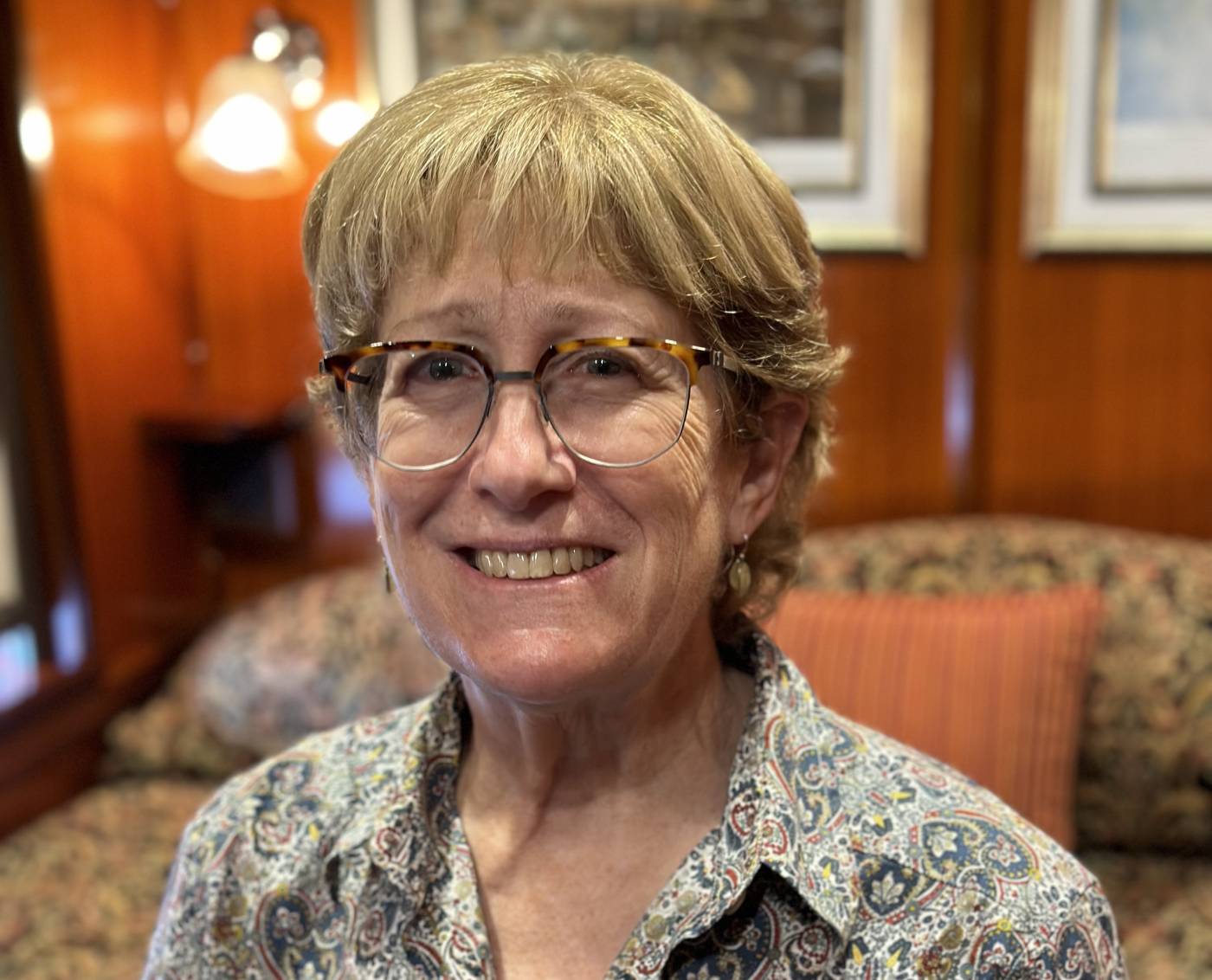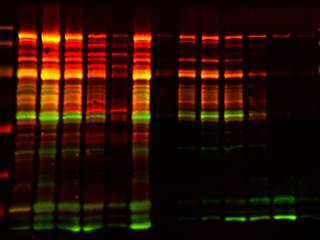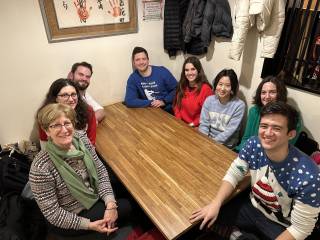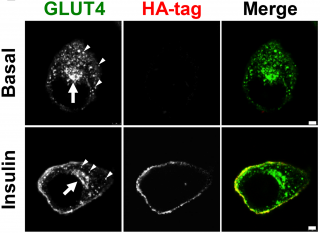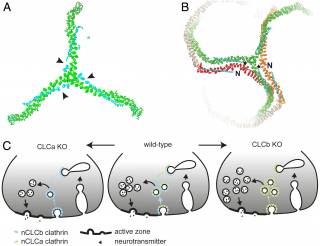Brodsky Lab

- The molecular basis for clathrin function.
- Clathrin proteins' roles in physiology, including lymphocyte function, glucose metabolism and oncogenesis, and potential therapeutic value.
- The genetic diversity and evolutionary origins of the clathrin proteins, and the functional consequences of clathrin subunit diversity.
Towards these goals, we employ a range of scientific techniques, including biochemical analysis, protein production and purification, mass spectrometry, tissue culture and cellular assays, electron and confocal light microscopy, physiological models and human and evolutionary genetics.
In 2014, Professor Brodsky moved from the University of California San Francisco to join UCL as Director of the Division of Biosciences, finishing her second term as Director in December 2020. The laboratory fully relocated to UCL in 2015 and is part of the Department of Structural and Molecular Biology in the Division of Biosciences, where Brodsky continues her research programme and teaching.
"Studying the remarkable self-assembling clathrin proteins has led us in diverse research directions, crossing interfaces between biochemistry, cell biology, immunology and metabolism. It is exciting and gratifying that our basic molecular studies are now revealing intracellular mechanisms and pathways that are directly relevant to several human diseases including infection, type 2 diabetes and cancer." - Frances Brodsky
Clathrins for Non-Scientists
At the Brodsky Lab, we are passionate about making our research as widely available and understood as possible. We have "translated" what our lab does into language we hope anyone can understand.

Our Research
The Brodsky laboratory has made significant contributions to understanding the structure, function and regulation of clathrin proteins. Research in the laboratory continues to investigate novel and conventional clathrin functions that are important for human health. Specifically, the lab is currently focussing on the following projects:
Project #1 – CHC22-dependent trafficking of the insulin-sensitive GLUT4 glucose transporter
Humans have two isoforms of the clathrin heavy chain (CHC), known as CHC17 and CHC22. CHC17 is ubiquitously expressed and is involved in a wide range of intracellular trafficking activities, most notably receptor-mediated endocytosis. In contrast, CHC22 is primarily expressed in muscle cells and performs a more specialised function in trafficking the GLUT4 glucose transporter to an insulin-sensitive, intracellular storage compartment. Whilst CHC17 has been extensively studied, much less is known about how CHC22 operates. One of the main research activities of our lab is utilising a combination of structural biology, biochemistry, genomics and cell biology to elucidate the mechanism, function, and regulation of CHC22 and its dependent pathways.
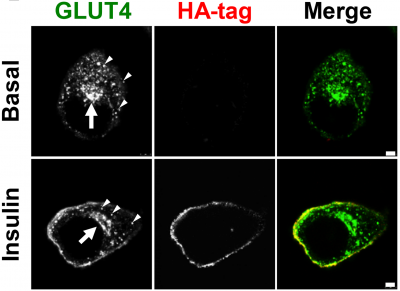
To read more, take a look at the summaries of our most recent publications on CHC22
Project #2 – Physiological functions of the clathrin light chains
The canonical form of clathrin is composed of CHC17 and clathrin light chains (CLCs). CLCs bind in a 1:1 stoichiometric ratio with CHC17 and are known to be required for the endocytosis of some (but not all) cargo to modulate the biophysical properties of clathrin (such as the ability of clathrin to deform membranes) and to mediate protein-protein interactions. However, the full scope of CLC functions remain to be defined. In particular, CLCs are encoded by two genes, which give rise to CLCa and CLCb, and tissue specific splice variants of these genes, resulting in a total of six CLC isoforms. CLCa and CLCb share about 60% identity, and each isoform and their tissue-specific distribution are conserved throughout mammalian species, suggesting that the CLC isoforms perform non-redundant, tissue specific roles. We are interested in understanding how diversity amongst the CLCs allows clathrin function to be fine-tuned to meet tissue-specific physiological needs.
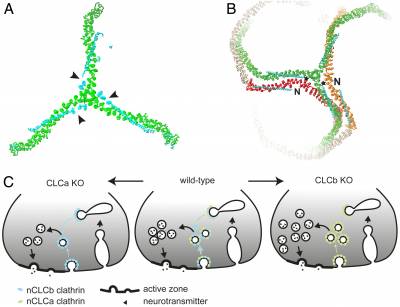
To read more, take a look at the summaries of our most recent publications on CLCs
Selected Publications
Clathrin light chains CLCa and CLCb have non-redundant roles in epithelial lumen formation. Chen Y, Briant K, Camus MD, Brodsky FM. (2023) Life Sci Alliance 7 (1) e202302175. DOI: 10.26508/lsa.202302175
Clathrin and Clathrin-Mediated Membrane Traffic. Bates GT, Briant K, Bultitude WP, Brodsky FM. (2023) Encyclopedia of Cell Biology (Second Edition). DOI: 10.1016/B978-0-12-821618-7.00155-3
CHC22 clathrin membrane recruitment uses SNX5 in bipartite interaction with secretory tether p115. Greig J, Bates GT, Yin DI, Simonetti B, Cullen PJ, Brodsky FM. (2022) bioRxiv DOI: 2022.12.21.520923
Antagonistic regulation controls clathrin-mediated endocytosis: AP2 adaptor facilitation vs restraint from clathrin light chains. Redlingshöfer L, Brodsky FM. (2021) Cells Dev. 25:203714. PMID: 34182181
Clathrin light chain diversity regulates membrane deformation in vitro and synaptic vesicle formation in vivo. Redlingshöfer L, McLeod F, Chen Y, Camus MD, Burden JJ, Palomer E, Briant K, Dannhauser PN, Salinas PC, Brodsky FM. (2020) Proc Nat Acad Sci USA 117: 23527-23538 PMID: 32907943
Clathrin’s life beyond 40: Connecting biochemistry with physiology and disease. Briant K, Redlingshöfer L, Brodsky FM. (2020) Curr Opin Cell Biol 65:141-149. PMID: 32836101
Building GLUT4 Vesicles: CHC22 Clathrin’s Human Touch. Gould GW, Brodsky FM, Bryant NJ. (2020) Trends Cell Biol 9:705-719. PMID: 32620516.
CHC22 clathrin mediates traffic from early secretory compartments for human GLUT4 pathway biogenesis. Camus SM, Camus MD, Figueras-Novoa C, Boncompain G, Sadacca LA, Esk C, Bigot A, Gould GW, Kioumourtzoglou D, Perez F, Bryant NJ, Mukherjee S, Brodsky FM. (2020) J Cell Biol. 219(1). PMID: 31863584
Genetic diversity of CHC22 clathrin impacts its function in glucose metabolism. Fumagalli M*, Camus SM*, Diekmann Y*, Burke A, Camus MD, Norman PJ, Joseph A, Abi-Rached L, Benazzo A, Rasteiro R, Mathieson I, Topf M, Parham P, Thomas MG, Brodsky FM. (2019) eLife. 8:e41517. PMID: 31159924 *Equal contribution.
Clathrin light chain A drives selective myosin VI recruitment to clathrin-coated pits under membrane tension. Biancospino M, Buel GR, Niño CA, Maspero E, Scotto di Perrotolo R, Raimondi A, Redlingshöfer L, Weber J, Brodsky FM*, Walters KJ*, Polo S*. (2019) Nat Commun. 10(1):4974. PMID: 31672988 *Co-corresponding authors.
CHC22 and CHC17 have distinct biochemical properties and display differential regulation and function. Dannhauser PN*, Camus SM*, Sakamoto K*, Sadacca LA, Torres JA, Camus MD, Briant K, Vassilopoulos S, Rothnie A, Smith CJ, Brodsky FM. (2017) J Biol Chem. 292:20834-20844. PMID: 29097553 *Equal contribution.
Please follow this PubMed link for a complete list of Prof. Brodsky's publications
Current Lab Members
The Brodsky lab is an interdisciplinary team of talented cell biologists, geneticists, and biochemists.
Read more about our current lab members or about Frances Brodsky
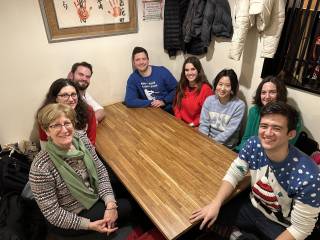
Positions Open
PhD Studentships
We currently have studentships available through the following PhD programmes:
- London Interdisciplinary Doctoral Programme (LIDO)
- UK Food Systems Centre for Doctoral Training (UKFS-CDT)
- UCL Birkbeck MRC DTP
Postdoctoral and Other Researchers
In the first instance, please send a CV and cover letter by email to Professor Brodsky and lab manager Kit Briant, including the names of referees and their email contact information.
The availability of positions fluctuates with the funding situation, so we encourage applicants to apply for fellowship support.
A research background in any of the following disciplines would be appropriate for current projects in the lab:
- Molecular cell biology
- Structural biology
- Biochemistry
- Human genetics
- Mouse models
When formal job advertisements are made, they will be posted on the UCL job website.
Lab News
2024:
- We are sad to say goodbye to our two MSci students, Lucia Fernandez Barreiros and Letizia Filippi. It has been a great pleasure hosting you both, and we wish you the best of luck in the future!
- Welcome to our two new post-docs, Kamila Kamuda and Alyce McClellan. Kamila moves to our lab after completing her PhD at UCL, within David Lomas' lab and will use her extensive electron microsopy experience to structurally characterise the GLUT4 storage compartment. Alyce finished her PhD in the Raffan group at the University of Cambridge and will look to characterise the cellular changes in the GLUT4 trafficking pathway during the pathogenesis of Type 2 Diabetes. Read more about them and others lab members here.
2023:

- We have published our latest work on clathrin light chains! Using mice and 3D cell culture models, we investigated the differential and cooperative roles for the CLC isoforms (CLCa and CLCb) in epithelial lumen formation. Take a look at the full paper here or our summary here!
- We are delighted to welcome two new MSci students to the lab - Lucia Fernandez Barreiros and Letizia Filippi. Lucia will investigate the molecular basis for protein-protein interactions of CLCa and Letizia will characterise the biochemical properties of alternatively spliced variants of CHC17.
- Check out Frances’ profile in Nature as part of their Career Q&A series - she talks about her double life as a cell biologist and crime writer.
- The Brodsky lab is well represented at this year's EMBO workshop in Venice on endocytosis (When biology of endocytosis meets physics: Emerging mechanisms and functions). Kit Briant is presenting his latest work on novel CLCa interactors, and Frances is giving a talk on how clathrin subunit diversity enables tissue-specific membrane traffic.
- Well done to our two summer research students, Iva Organdjieva and Camille Davidson! Iva was funded by a studentship from the Biochemical Society and investigated CLC interactors at endosomes while Camille worked on understanding the mechanism of CHC22 uncoating. Both will return to UCL in October to continue their undergraduate studies. Good luck for the future!
- Congratulations to George Bates for defending his PhD thesis! George has carried out some excellent work investigating molecular mechanisms regulating CHC22 clathrin function and will continue his research as a postdoc in the lab. Well done, George!
- We're sad to say goodbye to Lauren Foltz, who has gone on to take on a role as an Analyst at EmPartners. During her time at the Brodsky lab, Lauren worked on developing physiological models to characterise GLUT4 trafficking from induced pluripotent stem cells. Best of luck, Lauren!
2022:

- We're excited to share our latest preprint! Our study identifies a novel bipartite mechanism for CHC22 recruitment to the early secretory pathway involving p115 and SNX5 (sorting nexin 5)
- It's been a busy year of conferences for the Brodsky lab, with George Bates presenting posters at the BSCB (British Society for Cell Biology) conference at the University of Warwick with Josh Greig, at the Gordon Research Conference on Lysosomes and Endocytosis in New Hampshire (USA) and at an EMBO workshop on the Endoplasmic Reticulum
- Goodbye to our postdoc Will Bultitude! Will has worked on characterising the genetics of CHC17 and CHC22 since 2019 and has progressed to an editorial role at the journal Scientific Reports. Best of luck in the future, Will!
- We have a new book chapter on "Clathrin and Clathrin-Mediated Membrane Traffic" in the Encyclopedia of Cell Biology, providing a working knowledge for investigators in the field who encounter clathrin-mediated pathways in studies of associated physiology and disease.
- We're happy to announce that our former Master's student, Ivanna Yin, will join the lab as a new PhD student. Ivanna will work on further understanding the structural basis of clathrin assembly. Check out her profile here
- Farewell to lab technician Pallavi Ramsahye, who will go on to start a new role as a higher scientific officer at the Institute of Cancer Research. Good luck Pallavi!
2021:

- Welcome to our two new Master’s students, Ivanna Yin and Xinyi Zhang. Ivanna will work on the biochemistry of CHC22, and Xinyi will investigate the genetics of CHC17 and CHC22.
- Check out Lisa and Frances’ new publication reviewing the complementary roles of the AP2 adaptor complex and clathrin light chains in the regulation of clathrin-mediated endocytosis.
- Goodbye to our postdoc Yu Chen! Cherry has been with the lab since 2018 and has worked on characterising clathrin light chains in mouse models. She now takes up a position as a research scientist at Sanofi (Kymab).
- We’re happy to welcome our new lab technician, Pallavi Ramsahye!
2020
- Lisa’s paper has been published in PNAS! Take a look here! Lisa has been offered a position at the Max Planck Institute in Dresden – Congratulations and good luck in your new challenge!
- We’re delighted that our technician, Max, has been offered a PhD position at the University of Manchester to study metabolic engineering. Good luck Max!
- Another review is out! “Clathrin’s Life beyond 40: Linking biochemistry to physiology and disease” is published in Current Opinion in Cell Biology.
- Take a look at Frances’ review, now published in Trends in Cell biology.
- Congratulations to Hermione, who has completed her MSci! She’s off to do a PhD at the UCL Cancer Institute. Good luck!
2019
- Stephane’s paper has been published in JCB! Find out about how CHC22 functions in the early secretory pathway here. Good luck to Stephane and Marine in their new roles in Paris!
- Welcome to our new postdoc, Josh Greig! Check out our lab members here.
- We have a new PhD student! George Bates joins on the Wellcome Trust structural, chemical and computation biology PhD programme and will investigate the biochemistry of CHC22.
- Congratulations to our Master's student, Carmen, who has been awarded an MRes! Good luck with your PhD at the Francis Crick Institute!
- We have a geneticist in the lab - Will Bultitude joins us from Anthony Nolan Research Institute to investigate clathrin polymorphisms!
- We have a new research technician in the lab. Welcome Max!
- Our CHC22 phylogenetics study has been published is eLife. Read news coverage in The Economist, The Guardian and The Daily Mail.
- We hosted the Workshop to Discuss the GLUT4 trafficking Map at Chicheley Hall with support from the UCL FMS domain. Thanks to all those who attended! The consensus map can be downloaded from here.
2018
- We have posted a new preprint on how the evolution of the gene encoding CHC22 reveals selection influencing CHC22's role in human glucose metabolism.
- Welcome Yu Chen! Check out our new postdoc.
- Join us in congratulating Dr Lisa Redlingshoefer who was awarded her PhD on "Clathrin light chains modulate the biophysical properties and function of clathrin".
- Check out our first preprint ever!
2017
- Our lab published a new study in JBC demonstrating how CHC17 and CHC22 have distinct biochemical properties and display differential regulation and function.
- Welcome Alice Burke, our new tech!
- Frances has been elected to the EMBO membership. Congrats!
- Frances speaks at the Soapbox Science 2017: "The two-edged sword of human glucose metabolism". Soapbox science is an outreach platform for promoting women in sciences.
- Frances gives the 15th Randall lecture at King's College London: "Diversity of Clathrin Function in Membrane Traffic and Metabolism".
- The Food, Metabolism and Society Research domain website goes live! This group, created by Prof Brodsky, brings together researchers from across UCL and the Francis Crick Institute who work on diverse aspects of metabolic function and how metabolism and metabolic health impact society.
Older news:
2016
- Check out our new study on the role of Clathrin Light Chains' in selective endocytosis and its influence on isotope switching.
- We're happy to welcome a new post-doc: Kit Briant. Check him out!
- Frances gives a lecture at the University of York: "Diversity, Diabetes and Directing Traffic".
2015
- The Lab is growing. A new post-doc, Evelina Petitto, has joined our group!
- Frances has been elected to the Academy of Medical Sciences fellowship. This recognises her excellence in medical sciences. Congrats!
- UCSF says goodbye to Frances ! Check out the pictures from her farewell party.
2014
- Frances accepts the position of Director of the Division of Biosciences at UCL.
2013
- Check out Frances's interview published in the Journal of Cell Biology. "So you think you know all about Clathrin?"
2012
- Check this out: the lab publishes a study on the role of Clathrin in centrosome integrity in the Journal of Cell Biology. The article was selected to be featured on the cover of the August edition of JCB (see on the right) and was also the In Focus feature. This work was also featured in Nature Reviews' Research highlight.
2011
- Frances gives a lecture at the Karolinska Institute's for the Diabetes Day in 2011.
2000
- Frances co-founds the professional journal Traffic. Ten years later, she and Mark Marsh reflect on how it all began.
- Frances says a little bit about her life since graduating from Harvard in an interview to the Harvard Magazine.
 Close
Close


